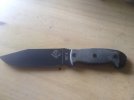Generally for fixed blades the break down of small (<4"), medium (4-6"), large (≥ 7") works. Most of us could be very comfortable carrying and using a "small" knife in he woods and I think for "survival". Personally, I'm comfortable with a SAK in most cases, but I generally choose something around 5"-6" as my normal woods knife size and keep the folder there for more delicate tasks.
Large are generally categorized as 7"+ blades, with the 7" sliding into your 6"-8" category. I would group the 6-8" fixed blades as utility knives (The BK-7 would be a good example.) and useful as a camp, or survival knife (whatever that means in reality). Years ago, I viewed a survival knife as a big fighting knife (Rambo-esk); essentially a strong 1/4" bar steel knife designed for both fighting or and woods use that you would be hard pressed to break. The smaller BK-2 or ESEE 5 would be a more compact version and mostly personal preference (but same application). I pretty much view the mixed use (fighting and woods) as a fantasy now. But fantasies are fun too. A lot depends on your experience and comfort level, and the knife itself being important relative to your feel for what you can use for cutting versus chopping. Anyone can chop with a knife but can they use it for much else conveniently? Does that make it a camp knife?
One might ask... what's so special about a "camp knife"? I mean you can split kindling, cut tent stakes, cut small trees for tarp supports or if so inclined or if you have to a shelter, chop food, cut meat, perhaps process meat, all with a 4" fixed blade. Your average Mora can do all of this too and probably better overall than many of the 6-8" knives. Personally I don't see anything particularly special about a camp knife classification. It's a catch all term where as many consider the medium to large size range suitable for a "camp knife". You use what you have the way I look at it.
The 8"+ knives are generally kind of beastly. The BK-9 is an example. Useful if you are willing to carry such and not so long that it's a royal pain flopping around on your belt. I generally want 10"+ for choppers which you could use to skin a squirrel or a deer, but not conveniently. Certainly for "survival" this size of knife has the most flexibility in the woods if you are willing to carry it and you are comfortable safely cutting stuff other than chopping limbs and small trees. In my opinion, you still need a folder for cutting small. The important thing is "Are you willing to carry it?" Are you willing to suffer the snickers by other hikers or the big eyes/looks by day hikers. It is much like choosing a folder for urban use.... size matters relative to use and other people.
There is a huge overlap in theoretical application for the small/medium/large size range. A lot depends on what you're used to or experienced with. Folks in Central and South America will only carry a 18" machete and use it for everything from cutting grass to vines to trees to field dressing or skinning an animal or fish to preparing food. They have no folder for cutting small.
Relative to this thread, the OP needs to decide what he plans on doing with the knife, what he's comfortable with, what his Mom is comfortable with, and if he would actually use it other than fondling it in his bedroom. I do that a lot by the way and one of my favorite activities for fixed blades.
I liked Creek Stewart's discussion on a survival knife quite a bit. His knife is a 5" spear point. Currently mine is my new BRKT Wilderness Explorer model (5.75"). My previous one was the Dozier Pro Guides knife. Self defense is always a possibility in the woods.... a bear or 2-legged predator if you are so unfortunate to encounter such without a firearm.



